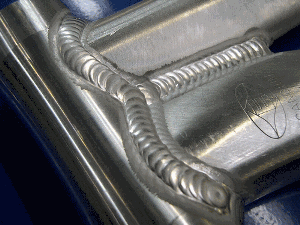aluminum
Aluminium is remarkable for the metal's low density and for its ability to resist corrosion. Structural components made from aluminium and its alloys are vital to the aerospace industry and are important in other areas of transportation and structural materials. Aluminum and magnesium are most often welded alloys using (AC) alternating current, but the use of direct current (DC) is also possible, depending on the properties desired. Before welding, the work area should be cleaned and from any grease and dirt. AC current can provide a self-cleaning effect, removing the thin, refractory aluminium oxide (sapphire) layer that forms on aluminium metal within minutes of exposure to air. When alternating current is used, pure tungsten electrodes or zirconiated tungsten electrodes are preferred over thoriated electrodes, as the latter are more likely to "spit" electrode particles across the welding arc into the weld. Blunt electrode tips are preferred, and pure argon shielding gas should be employed for thin workpieces. Introducing helium allows for greater penetration in thicker workpieces, but can make arc starting difficult. As shown below TIG welding aluminum can be a work of art.
